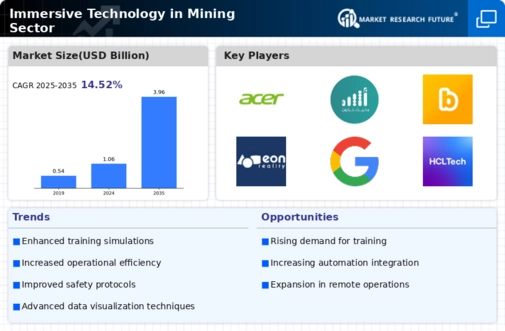Market Trends
Key Emerging Trends in the Immersive Technology in Mining Sector Market
The market for Immersive Technology in the Mining Sector is an emerging industry that could change the global mining sector by improving safety standards and increasing efficiency in operations at different levels of productivity. In this regard, some of these companies seek to occupy leading positions by using various methods, such as market share positioning strategies within this context. The first approach involves safety and training, which is one of the primary strategies used by firms involved in Immersive Technology within Mining Sector Market today. Solving this challenge requires realistic experiences that only virtual reality(VR )and augmented reality(AR) can provide for staff working underground within mines as well as extraterrestrial human beings on other planets. Mining simulators that provide real-world scenarios are essential for ensuring that trainees gain practical knowledge about how they operate safely under these hazardous conditions. Immersive technologies like virtual reality can simulate dangerous mining situations where employees can practice emergency actions, thereby enhancing their preparedness. In addition, AR overlays digital information onto real-world mining environments so that workers get ongoing safety alerts, instructions for operating equipment, or warnings of dangers. Another aspect of Immersive Technology in Mining Sector that must not be ignored is remote monitoring and control. Remote locations with harsh terrains are the usual environments where mining activities take place, hence making it difficult for people to reach these sites and monitor their operations in real time. In this context, immersive technologies combined with advanced connectivity will enable companies to monitor and control their mining operations from a distance. These corporations can attract customers who value operational efficiency and cost-effectiveness by positioning themselves as providers of advanced remote monitoring and control solutions. Mining firms also embrace collaboration and partnerships as key strategies in the Immersive Technology within the Mining Sector Market. As a result, most mining companies form relationships with technology providers, software developers, or research institutions to boost their immersion capabilities. In turn, this enables them to leverage cutting-edge technologies provided by established players while at the same time taking advantage of existing research networks through accessing sophisticated simulation software. Additionally, market share positioning requires productivity optimization in the Immersive Technology in Mining Sector market. Numerous applications can help optimize mining workflow using virtual reality technology, thus leading to increased operational efficiencies coupled with reduced downtimes. A good example is VR, which provides miners with an opportunity to emulate the extraction process, thus identifying areas that need improvement, such as the location of machines or workflow optimization. Furthermore; AR offers real-time instructions instead of having operators go back to manuals so that they make efficient assessments. Another application could be given by employing immersive solutions for better work performance, which would mean added output, reduced costs incurred during processes, and more competitive standing among other players. By offering productivity enhancement products, producers can improve output capacity while decreasing input costs, thereby enhancing competitiveness amongst them.


 Source: Secondary Research, Primary Research, MRFR Database and Analyst Review
Source: Secondary Research, Primary Research, MRFR Database and Analyst Review









Leave a Comment